-
Schumacher Cougar SV -
Words & Pictures: Arn0
Shocks
|
Big
bores shocks are probably the most visible and expected items on
this car, at least for the Pro Spec version.
Schumacher
gets rid of the past and has designed brand new shocks from scratch.
Forget the foams to achieve constant volume, forget the shims to
set the ride height (or spring preload). These new shocks use an
upper cap which includes a bladder to maintain the constant
volume. The shock bodies are treaded to allow some spring preload
via a collar and two seals held by housing to avoid an oil leak
around a standard diameter shaft. Things are looking very good up
to now.
But
there is much better coming. The internal diameter is about 13mm,
yes 13mm! 3mm bigger than standard shocks. In consequence, pistons
are bigger than usual, square edged and offering 6 and 4 holes
for, respectively, the rear and the front shock. Springs are also
bigger with a 15mm diameter, front ones have a spring rate of
3.5lb/in and rear ones 2.5lb/in. |

All components for the front shocks
including 6 holes pistons
|
As
options to get the finest tune possible, front springs are available
from 2.0 to 5.0lb/in and rear ones from 1.6 to 4.0lb/in, with an
increase of 0.5lb/in. In addition, more pistons are available: a 2-holes
piston (square edged) and two round edged pistons with 3 and 5 holes. By
combining these parameters and mixing them with the various oil grades
you have almost infinite possibilities to set your suspension.
|
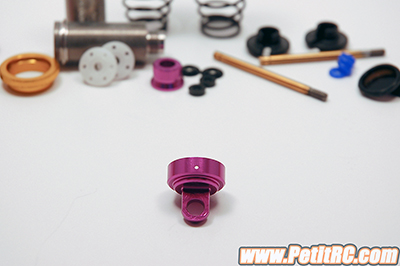
|
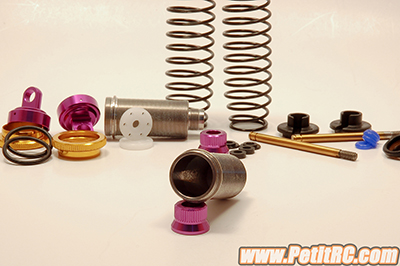
Make sure to clean the inside of the shock's bodies as there
is some remaining oil from the manufacturing process
|
For the assembly process,
first be sure to clean the shock bodies as there is some lubricant left
over from the machining process covering both the inside and outside
surfaces. Avoid any break cleaner that might tend to mix with oil and
prefer a smooth tissue. Prior to assembly, oil the o-rings that will
seal the bottom part of the body or, even better, use Green Slim and
your dampers will work like magic. Pistons are maintained on the shaft
with e-clips, a classical but efficient design.
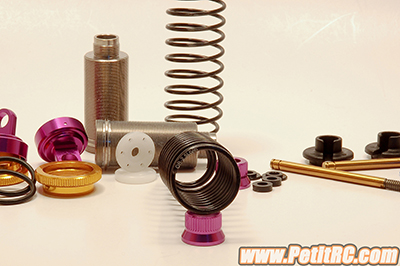 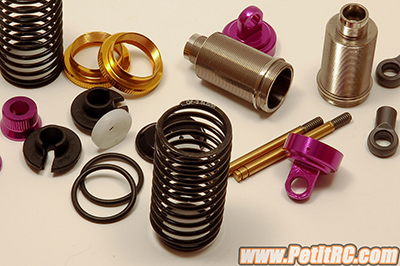
On the left hand side is the front
spring. On the right, the rear one appears
Schumacher advises some 35wt
all around as a starting point. Once you have filled them with oil, let
everything rest sufficiently to get rid of every single tiny air bubble
inside the oil. You could even move the piston up and down to obtain a
fastest air release. Tighten the cap but not too much; be gentle here to
avoid damaging the bladder and springing a leak.
|
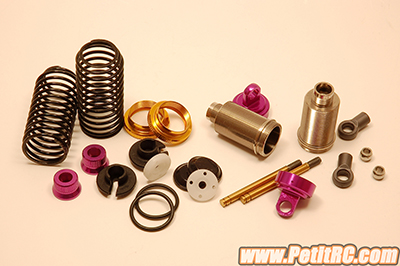
The components for the rear shocks, note the 4holes piston
comparing with the front ones
|
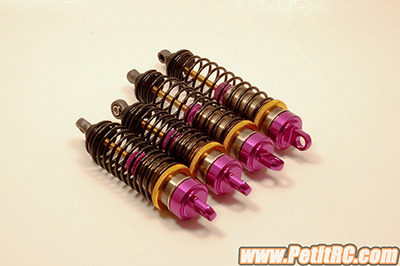
Once assembled
|
One thing to consider,
however, is that the shafts are made of steel, nothing wrong with steel
but hardcore drivers may consider, as the turnbuckles, swapping them for
titanium ones.
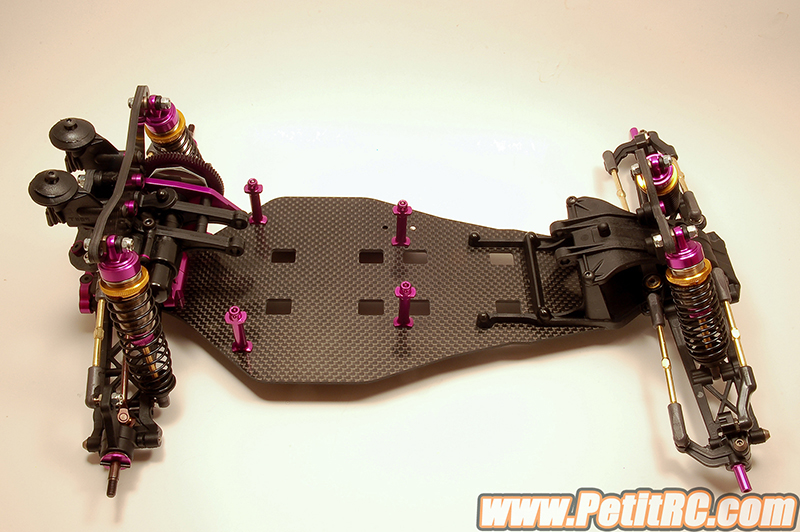
Fitted with shocks, the car is almost done
Battery Holder
One of the most significant
features which has not been mentioned earlier
is the battery position as well as for which type of battery this car
was designed. Schumacher forgets the sub-C type battery and only focuses
on Lithium-Polymer (LiPo). And that's a
smart move as LiPo cells only have
advantages compared with NiMH cells in terms
of performance, maintenance and ... well you know all about those
batteries.
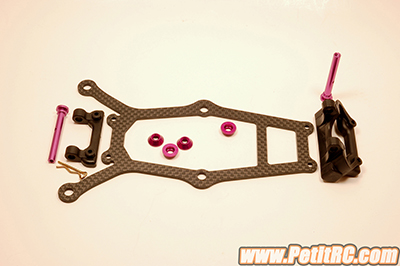 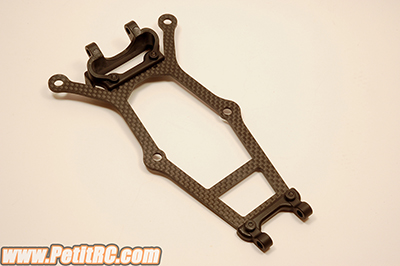
Ok, back to this battery holder. It is
also the top desk once you secure the battery.
And here Schumacher makes use of his previous experience with TC cars
providing some setting options to allow the chassis to flex more or less
depending how you decide to secure your battery. This top desk is
mounted hinged on the front bulkhead and pinned on the transmission
casing. After all it is up to you to adjust the chassis stiffness with
either screws or clips by using all or part of the posts.
Here is a chart with some configuration
when the provided battery holder, values are percentage of stiffness:
| Screws |
Clips |
4
posts |
2
posts in middle |
2
posts in rear |
0
post |
| 4 |
0 |
100 |
- |
- |
- |
| 2
in middle |
2
in rear |
80 |
- |
- |
- |
| 2
in rear |
2
in middle |
70 |
- |
- |
- |
| 2
in middle |
0 |
50 |
45 |
- |
- |
| 0 |
4 |
60 |
- |
- |
- |
| 2
in rear |
0 |
40 |
- |
35 |
- |
| 0 |
2
in middle |
35 |
30 |
- |
- |
| 0 |
2
in rear |
25 |
- |
20 |
- |
| 0 |
0 |
10 |
- |
- |
0 |
|
To
be more accurate, some measure of torsional
stiffness of the chassis must be done and, as a
consequence, you may take the above values as estimates.
The
manual specifies a maximum height of 25.1mm for the LiPo
battery which allows you to use the battery you want as long as it is
part of the federal list form you geographical area (EFRA, ROAR, FEMCA
or FAMAR).
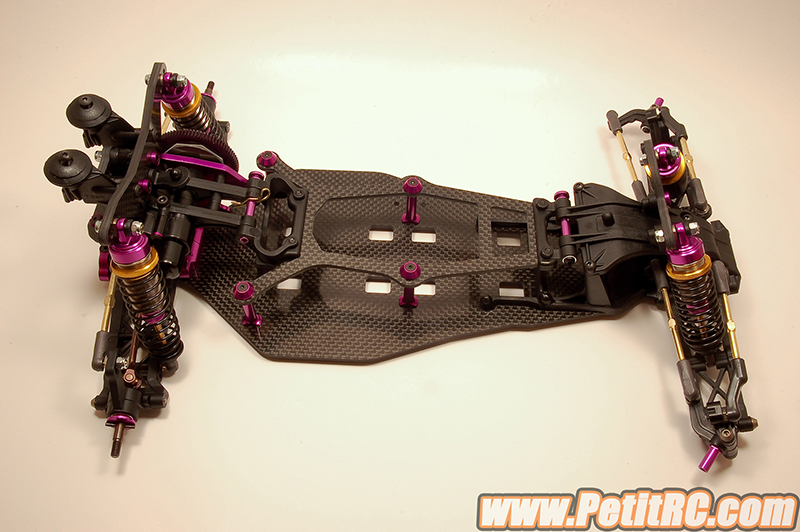
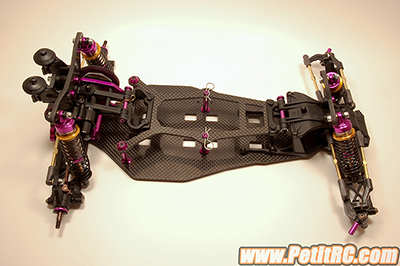
Screws on the rear, clips in the middle |
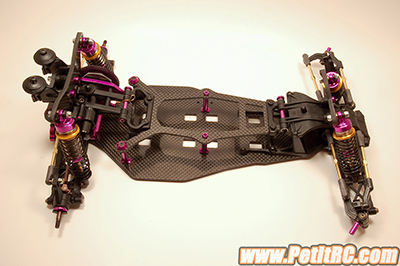
Screws on the rear, nothing in the middle |
|
|
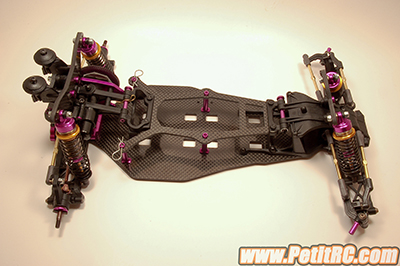
Clips on the rear, nothing in the middle |
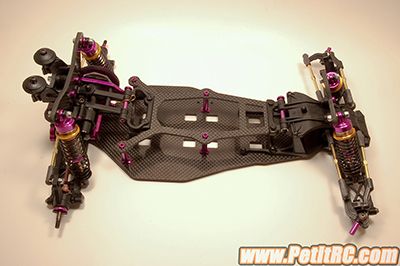
Loose, no screws or clips |
In
addition to the provided top desk, Schumacher offers two other parts
which give less flex. The first option will give a fairly similar result
as you remove the rear posts. More interestingly, the second option will
provide a more flexible car but as the shape is nothing similar to the
kit desk, you can expect some good results.
By
all means, this tuning possibility needs to be explored to gain an
understanding of the effects of changing the car stiffness to match
track conditions.
|
